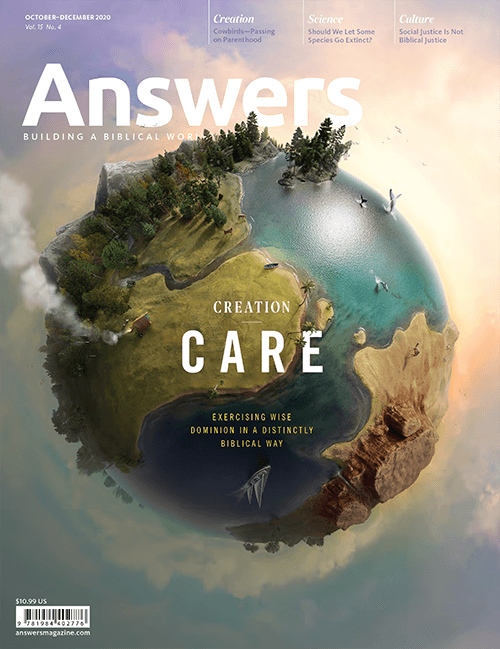
Should We Abandon Some Species to Extinction?
Creation Care
As God’s creatures disappear, Christians have the opportunity to model the Creator’s spirit of wise conservation.
Benjamin lay in Tasmania’s Beaumaris Zoo, frozen to death after being left outside his enclosure on a cold night in 1936. Benjamin was a thylacine, or Tasmanian tiger, the largest living marsupial (pouched) carnivore of his day. He had a body as big as a medium-size dog, striking black stripes against yellow-brown fur, and a stiff kangaroo-like tail. When threatened, he could open his jaws a whopping 80º in a behavior called a threat-yawn.
But you’ll probably never get the chance to see this unique creature in real life. The same year Benjamin died as the last captive thylacine, Tasmanian tigers were also declared extinct in the wild, hunted to annihilation by people who had perceived the animals as an unmanageable threat to their livestock.1
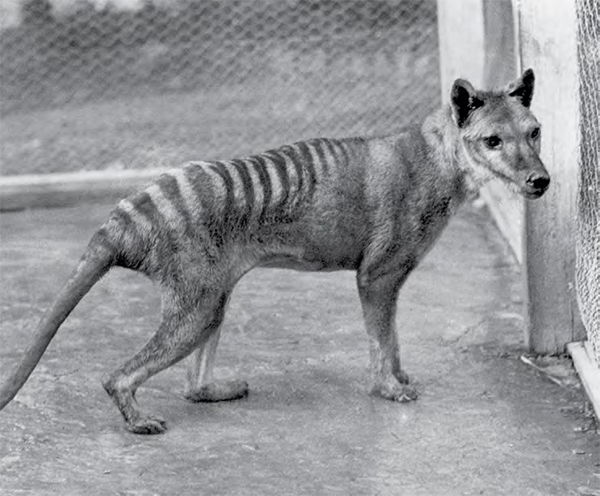
Not long after Benjamin, the last captive Tasmanian tiger, died in Tasmania in 1936, his entire kind faded to extinction.
Thylacines are just the tip of the extinction iceberg. Over the last 400 years, we’ve lost the golden toad, passenger pigeon, Caribbean monk seal, dodo, western black rhinoceros, Javan tiger, and many others. Currently, several endangered species could go extinct in the next few years, including Amur leopards and tigers, orangutans, Sumatran and Asian elephants, blue whales, bluefin tuna, and hawksbill turtles.
Secular environmentalists are quite concerned about disappearing species. But how are Christians to respond to the loss of these creatures?
God didn’t intend this dominion to include ravaging the land, being careless with the environment, or destroying creatures on a whim.
When God gave his image bearers the responsibility of ruling the organisms in creation, he defined one of our purposes on earth. With careful attention to the Hebrew text and context as well as to the language and culture of the time, the words of God in Genesis state that God made man in his image and likeness. It is clear in God’s Word that image and likeness refer to sonship with our Father and servant kingship with creation. Servant kingship includes ruling the fish of the sea, birds of the air, and every living creature that moves on the ground (Genesis 1:27–28). God didn’t intend this dominion to include ravaging the land, being careless with the environment, or destroying creatures on a whim.
God set an example for us as servant rulers by commanding Noah to take at least two of every air-breathing, vertebrate animal kind on the ark. He saved these creatures so they could multiply and refill the earth after the devastation of the flood. When Christians live out God’s command by caring for fading diversity, they have a chance to demonstrate the Creator’s intent for conservation.
Threatened Species
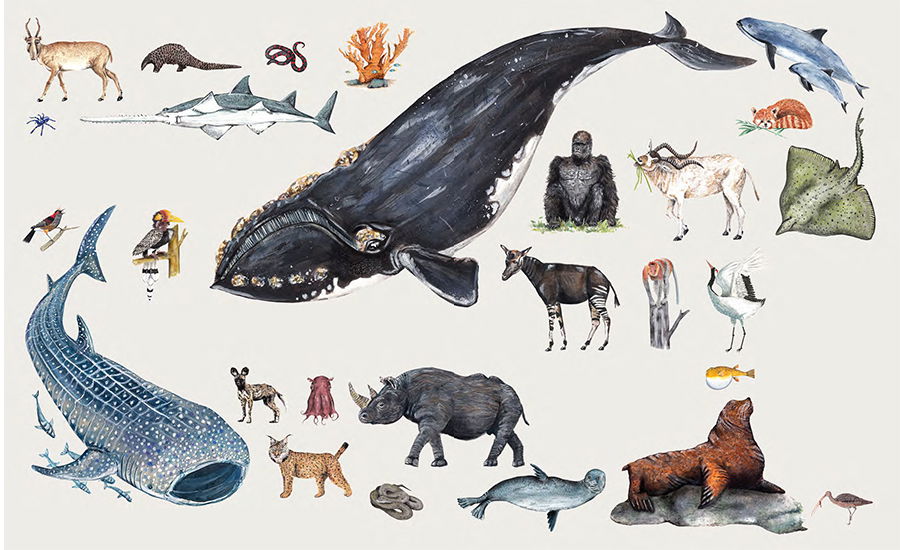
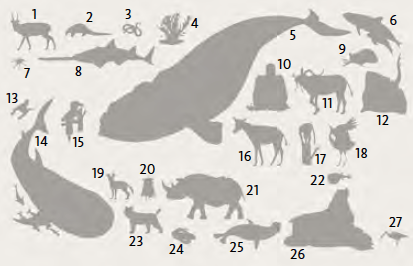
Art by Malachi Studio
The International Union for Conservation of Nature (IUCN) estimates that over 14,000 animal species are either critically endangered, endangered, or vulnerable. The opening pages feature only a few of the magnificent creatures that one day might be extinct.
1) Saiga antelope 2) Indian pangolin 3) Honduran red-banded earth snake 4) Elkhorn coral 5) North Atlantic right whale 6) Vaquita 7) Gooty sapphire ornamental tarantula 8) Smalltooth sawfish 9) Red panda 10) Western gorilla 11) Addax 12) Common skate 13) ʻAkohekohe 14) Whale shark 15) Helmeted hornbill 16) Okapi 17) Proboscis monkey 18) Red-crowned crane 19) African wild dog 20) Opisthoteuthis chathamensis 21) Black rhinoceros 22) Chinese puffer fish 23) Iberian lynx 24) Antiguan racer 25) Mediterranean monk seal 26) New Zealand sea lion 27) Eskimo curlew
Why Should We Save Species?
When a species wanes or goes extinct, its ecosystem may fall out of balance and become unstable because each creature contributes to the overall health of an ecosystem.
When a species wanes or goes extinct, its ecosystem may fall out of balance and become unstable because each creature contributes to the overall health of an ecosystem. An unhealthy ecosystem isn’t self-contained—it functions within a larger context, inevitably affecting humans in some way. For example, hemlock trees on the east coast of the USA are being killed by an invasive insect known as the hemlock woolly adelgid. In certain places in the South, skeleton trees tell a story of mass death in large areas of the forest, especially near streams. With their shade, these trees cooled the streams, allowing more oxygen to be dissolved in the water and creating optimum habitat for stream insects. More insects resulted in healthy trout populations, fueling recreational fishing and breathing economic life into the tourist industry. The death of hemlock trees functions within a larger ecosystem. We are wise to preserve diversity since species often provide soundness to an ecosystem.
We should also preserve species for the benefits we might derive from them. God’s design in nature inspires new technologies (biomimicry) that make our lives safer and our products more efficient. For example, scientists looked at whale fin design to create a better model for airplane propellers, and a recent study of mussel adhesion could help create a product to clean up oil spills.
Today many prescribed medicines come from plants or other natural products, and scientists are constantly turning to nature for its health benefits. For example, turmeric root has anti-inflammatory properties while evening primrose can improve the quality of life for those suffering from multiple sclerosis and polycystic ovary syndrome. These are just two of thousands of plants that researchers are actively investigating for beneficial properties. It’s up to us who bear God’s image to steward the environments in which these plant species grow.
Research also suggests that enjoying and immersing in beautiful and diverse environments bring emotional and spiritual well-being by reducing anxiety, lowering blood pressure, and calming our minds in a fast-paced, chaotic world.
Beyond considering the practical reasons for preserving species from extinction, we must remember that creation exists, in part, to declare God’s glory and remind us to worship him. His invisible attributes are manifested in the physical creation (Romans 1:20). His infinite wisdom and artistry are also revealed in the stunning engineering, aesthetics, and symmetry of all life. With every extinct species, we lose valuable insight into our heavenly Father’s creative mind, characteristics, and care for his creatures.
The species we see today diversified from the original kinds God called “very good” in Eden. However, even in the fallen world, we do not need to justify or market the worth of a species based on its ecological, sociological, utilitarian, spiritual, and aesthetic characteristics.
These creatures are intrinsically valuable because they are his. None are merely expendable or disposable. Of course, we must wisely manage disease organisms, dangerous animals, urban pests, and invasive plants that wreak havoc on people, their livelihoods, and other creatures. Examples of these include fungal wood rots and defoliating predators of forest and orchard trees, invasive pythons of the Florida everglades, and the kudzu vines inundating the southeastern United States. However, we should strive to avoid waging a war to extinction.
Keeping the Keystones
Keystone species are organisms that play vital roles in supporting and maintaining the structure and biodiversity of their ecosystems. Their loss would negatively affect their entire ecological community.
The International Union for Conservation of Nature (IUCN) is the global authority on the status of species throughout the world and develops solutions to save them.
Types of Keystone Species
- Predator—controls the population and range of other animals
- Plant—provides food or shelter for other species
- Mutualist—interacts with other species in a vitally reciprocal way
- Engineer—creates, modifies, or maintains the landscape

Art by Malachi Studio
Sea Otter
(Enhydra lutris)
Predator Keystone
- Lives in the Pacific coastal waters of northwestern North America
- Sea otters hunt in kelp forests, eating sea urchins and other marine animals. As a habitat for various marine mammals, fish, and invertebrates, kelp forests keep biodiversity healthy, provide food for a variety of birds, and dissipate the erosion from ocean waves on nearby coastlines.
- Without sea otters, sea urchin populations would skyrocket and destroy the kelp forest, collapsing the rest of the community. Nearby coastlines would possibly erode, potentially affecting human structures and the tourism industry.
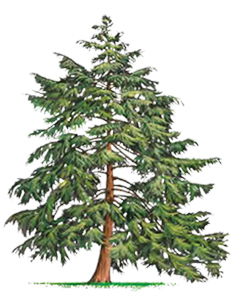
Art by Malachi Studio
Eastern Hemlock
(Tsuga canadensis)
Plant Keystone
- Grows in eastern North America
- These trees provide shade that cools surrounding streams, allowing more oxygen to be dissolved in the water and creating an optimum habitat for aquatic life, especially insects. More insects promote healthy trout populations, fueling recreational fishing, which is important for tourism industries.
- Without shade trees, water temperatures increase, decreasing dissolved oxygen and threatening the native species that thrive in cold water.

Art by Malachi Studio
Southern Cassowary
(Casuarias casuarias johnsonii)
Mutualist Keystone
- Lives in the rainforests, grasslands, and wetlands of northeastern Australia, New Guinea, and the Seram and Aru Islands of Indonesia
- Cassowaries are important seed dispersers. These birds consume as many as 238 different plants, including some toxic fruits that other animals can’t eat. Their gentle digestive system allows the seeds to survive and be distributed over large areas, maintaining local biodiversity.
- Without cassowaries, plants would be at risk of local extinction. The absence of these plants would alter the diversity of the surrounding ecological structure.

Art by Malachi Studio
African Bush Elephant
(Loxodonta africana)
Engineer Keystone
- Lives in the forests, savannahs, and wetlands of sub-Saharan Africa
- Elephants push down trees to eat their foliage, helping to minimize forest fire outbreaks. This also increases the size of savannas, which house a diversity of herbivores (such as zebra and antelope), carnivores (such as lions and leopards), and scavengers (such as hyenas and vultures). Elephants also dig holes in dry riverbeds for water storage in the rainy season and disperse seeds of the baobab tree (Adansonia sp.), whose fruit is food for both animals and people.
- Without elephants, baobab dispersal would decrease and forests would increase, reducing the biodiversity of the savannas and potentially causing this vital biome to collapse.
The Problems with Conservation
Secular environmentalists are usually Darwinian evolutionists, meaning that they value humans and animals equally since they believe we descended from the same ancestor. By rejecting the reality of an all-powerful God, they believe that humans alone are in full control of the world’s existence.
As Christians, we can take a more balanced approach, understanding that though we have a responsibility to tend the earth, we are not the final power in charge of it. We also understand that because of the curse, species have risen and gone extinct throughout history. Catastrophic processes caused some extinctions, and many others have disappeared by our own unwise and uncaring attitudes and actions.
Still, even knowing that death is unavoidable in a fallen world, as an ecologist, I feel a sadness when I reflect on how much biodiversity we have lost over the centuries. We must consider the real challenges of protecting and caring for God’s creatures.
Environmental Triage
Conserving species costs an exorbitant amount of time and money. One study estimated that it would take $58 billion annually to reduce the extinction risk and maintain the protected areas for all 26,000 endangered species.2
Despite the time and money expended to save them, many species continue declining in numbers. For example, because of habitat destruction, oil and gas exploration, and increased predation, the population of Canada’s woodland caribou continues to decrease even with millions of dollars and countless work hours spent on their recovery.
Though most conservationists refuse to abandon any species to extinction, a few wonder if we should let some species disappear so that we can focus finances and energy on other organisms that have a better chance of being saved. Some conservationists propose triaging each species to determine the feasibility of restoring them back to healthy populations. Just as a medic prioritizes injuries in a mass disaster based on severity of injury and reasonable chance of survival, so conservation biologists could use triage to identify and focus on threatened species with a reasonable chance of comeback.
Conservationists might also triage by considering keystone species. More than other creatures, keystone species have more impact on maintaining their ecosystem. For example, the sea otter’s presence in its environment produces a stable and healthy community for a score of other organisms. Sea otters hunt in kelp forests, eating sea urchins and other marine animals. Kelp forests are an important habitat for a variety of fish and marine invertebrates that result in not only keeping biodiversity healthy but also helping dissipate the power of ocean waves to protect nearby coastlines. Historically, when otters were removed through hunting, sea urchin populations skyrocketed and destroyed the kelp forests, causing these diverse communities to collapse.
Managing keystone species and the health of their habitats will automatically bring positive results for many other species, allowing us to be good stewards of time and resources.
A God of Conservation
Our rebellion against God broke our relationship with him, with one another, and with the creation. In response to our sin, he cursed this world. However, even in a fallen world, God’s statements about our purpose and his creatures have not changed. But perhaps our sometimes careless attitude should.
I’ve heard fellow believers respond to the issue of extinction in unsettling ways: “Maybe it’s just God’s will for these species to go extinct. After all, animals aren’t as valuable as humans because they aren’t made in God’s image,” and “God’s going to destroy the planet when he recreates the new heavens and earth anyway,” and “Christians need to reach souls and not hug trees with leftist environmental wackos.” But the dismissive spirit of these responses seems counter to what we know about the Creator’s redemptive plans.
The triune God spared no effort to restore the relationship with his image bearers. In fact, the Creator became flesh and dwelt among his creation when God the Son, Jesus, walked the earth, taking the punishment for our sin and offering those who believe in him a new beginning with God.
The Holy Spirit indwells believers, enabling us to mirror God’s perspective even in the area of caring for and conserving species. In his book Pollution and the Death of Man, Francis Schaeffer put it this way: “If I love the Lover, I love what the Lover has made.” The more we care about the things that matter to Jesus, the more we will be involved in their care. What if we more intentionally trained our children to enjoy creation and to be lifelong learners of our world and its creatures?
What if Christians entered fields such as biology and environmental sciences to work in conservation? What if we recognize our identity as sons and daughters of the King and exercise our ordained servant dominion over creation? Our concern for creatures on the brink of extinction could serve as a way to tell unbelieving environmental biologists the good news of our Creator and Savior who gave himself to snatch us from the brink of eternal death.

Art by Malachi Studio
Can We Bring Back Species from Extinction?
In recent decades, some scientists have been captivated by the thought of bringing species back from extinction (de-extinction). By sequencing the genomes of current species and inserting the DNA from genetic samples of extinct species preserved in museums and zoos, they hope that quaggas (a species of zebra), woolly mammoths, and passenger pigeons might roam this world once more.
But de-extinction programs are expensive, time consuming, rigorous, and, so far, have resurrected no species.
Even if we can someday bring a creature back from extinction, perhaps a better question is “Should we?” Creatures brought back from extinction would live in a world much different from the one in which they formerly thrived (Jurassic Park, anyone?) Habitats have changed, and other organisms they interacted with in symbiotic (mutually helpful) relationships may not still exist. These de-extinct creatures could disrupt the dynamic of other habitats by becoming pests or carriers of disease. If the habitat for a species is no longer viable, bringing an extinct species back would be a waste of time and effort.
God calls us to be good stewards of the earth—that includes wisely allocating our resources. Rather than bringing back species that might harm our current ecosystems, we should focus our energies and resources on things that will benefit humans and ecosystems now and in the future. We can start by conserving endangered creatures that have a fighting chance and by maintaining ecosystems on which large populations of species depend.
Answers Magazine
October–December 2020
When it comes to creation care, Christians have a deeper calling than secular environmentalists.
Browse IssueFootnotes
- Some people adamantly claim the Tasmanian tiger is still alive due to various unsubstantiated sightings.
- Donal P. McCarthy et al., “Financial Costs of Meeting Global Biodiversity Conservation Targets,” Science 338, no. 6109: https://science.sciencemag.org/content/338/6109/946.
Recommended Resources

Answers in Genesis is an apologetics ministry, dedicated to helping Christians defend their faith and proclaim the good news of Jesus Christ.
- Customer Service 800.778.3390
- Available Monday–Friday | 9 AM–5 PM ET
- © 2025 Answers in Genesis


